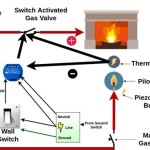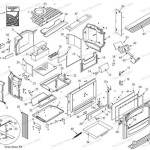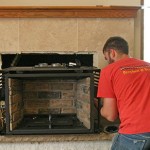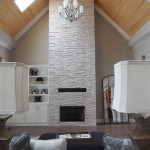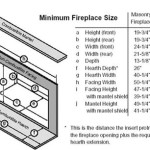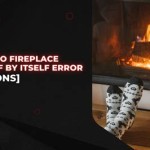Understanding Insulated Fireplace Covers: Protecting Your Home and Saving Energy
An insulated fireplace cover is a specialized accessory designed to enhance the safety and energy efficiency of homes with fireplaces. These covers, also known as fireplace plugs, chimney balloons, or chimney pillows, serve as a barrier to prevent heat loss and drafts when the fireplace is not in use. By effectively sealing the fireplace opening, insulated covers contribute significantly to reducing energy bills and maintaining a comfortable indoor environment.
Fireplaces, while aesthetically pleasing and capable of providing warmth, can also act as significant sources of energy loss. When not in use, the chimney essentially becomes a large, uninsulated hole leading directly to the outdoors. This allows heated air to escape during the winter months and cool air to escape during the summer, placing an unnecessary strain on HVAC systems and increasing energy consumption.
Therefore, an insulated fireplace cover plays a crucial role in mitigating these drawbacks and optimizing the overall energy performance of a home. This article will provide a comprehensive overview of insulated fireplace covers, exploring their benefits, types, selection criteria, and installation considerations.
Key Benefits of Using Insulated Fireplace Covers
The primary benefit of an insulated fireplace cover is its ability to reduce heat loss and prevent drafts. By sealing the fireplace opening, the cover minimizes the flow of air between the interior of the home and the outside environment. This prevents warm air from escaping up the chimney during the heating season and prevents cold air from entering during the cooling season. This directly translates into lower energy bills and a more comfortable living space.
Beyond energy efficiency, insulated fireplace covers offer additional advantages. They prevent pests, such as insects, rodents, and birds, from entering the home through the chimney. This is particularly important in preventing potential damage to property and maintaining hygienic living conditions. The covers also prevent debris, such as leaves, twigs, and rainwater, from entering the fireplace, keeping it clean and ready for use when needed.
Furthermore, some insulated fireplace covers offer a degree of fire protection. While not designed to extinguish existing fires, they can help to contain embers and prevent them from spreading if a fire is not completely extinguished before leaving the house. The insulation material used in these covers can resist high temperatures and prevent radiant heat from igniting nearby flammable materials.
Types of Insulated Fireplace Covers
Insulated fireplace covers are available in various designs and materials, each offering specific advantages. One common type is the inflatable fireplace plug, which consists of a durable, inflatable balloon made of vinyl or rubber. The balloon is inserted into the fireplace opening and inflated using a hand pump, creating a tight seal against the walls of the firebox.
Another type is the foam fireplace plug, which is typically made of dense polyurethane foam. These plugs are cut to fit the dimensions of the fireplace opening and provide a solid barrier against air leakage. Foam plugs are generally easy to install and remove, and they offer good insulation properties.
A third type is the fabric fireplace cover, which consists of a heavy-duty fabric filled with insulating material, such as fiberglass or mineral wool. These covers are designed to be placed over the fireplace opening and secured with straps or magnets. Fabric covers offer good insulation and can be customized to fit various fireplace sizes and shapes.
More advanced options include magnetically sealed covers. These feature a metal frame with magnetic strips that attach to the metal firebox, creating a secure and airtight seal. These options are often more expensive but offer superior performance in terms of insulation and draft prevention.
Factors to Consider When Selecting an Insulated Fireplace Cover
Choosing the right insulated fireplace cover depends on several factors, including the size and shape of the fireplace opening, the desired level of insulation, and the budget. It is crucial to accurately measure the height and width of the fireplace opening to ensure a proper fit. An improperly sized cover will not provide a tight seal and will therefore not be effective at preventing air leakage.
The R-value of the insulation material is another important consideration. The R-value is a measure of thermal resistance, and a higher R-value indicates better insulation performance. For maximum energy savings, it is recommended to choose a cover with a high R-value. The materials used in the cover's construction also affect its durability and longevity. Look for covers made of durable, weather-resistant materials that can withstand the harsh conditions inside a fireplace.
The ease of installation and removal is also a key factor. Some covers, such as inflatable plugs and foam plugs, are relatively easy to install and remove, while others, such as fabric covers with straps, may require more effort. Consider the frequency with which the fireplace will be used and choose a cover that is convenient to use.
Finally, consider any specific features or functionalities that may be desired. For example, some covers may be designed to be aesthetically pleasing and blend in with the décor of the room. Others may offer additional safety features, such as fire-resistant materials or tamper-proof locks. When choosing, safety should be the top priority to ensure it is appropriate for your needs.
Once the appropriate cover has been selected, proper installation is essential. Follow the manufacturer's instructions carefully to ensure a tight and secure seal. Regular maintenance, such as cleaning the cover and checking for signs of wear and tear, will help to prolong its lifespan and maintain its performance.

How I Created An Insulated Fireplace Cover With Pallet Wood Diy Doors

Fireplace Cover Insulation Draft Blocker Fireproof Magnetic Blanket For Heat Loss Flue Cold Air 39 W X 32 H Com

How I Created An Insulated Fireplace Cover With Pallet Wood Up Diy

Magnetic Fireplace Cover For Inside Stops Heat Loss Blanket Draft Stopper Winter Summer Hot Cold Air Blocker 44 W X 33 H Insulated Flame Yahoo Ping

Achla Designs 40 In L Black 3 Panel Steel Draft Guard Cover Dgc 01 The Home Depot

Walls Behind Fireplaces Building America Solution Center

Insulated Fireplace Cover Decorative Blanket Draft Stopper Stopps

Fireplace Fire Mat For Area Carpet Protection Flame Ant Fiberglass Insulation Blanket Fruugo No

Choice Insulation Fireplaces

Magnetic Fireplace Cover For Inside Stops Heat Loss Blanket Draft Stopper Winter Summer Hot Cold Air Blocker 44 W X 33 H Insulated Flame Yahoo Ping
Related Posts

